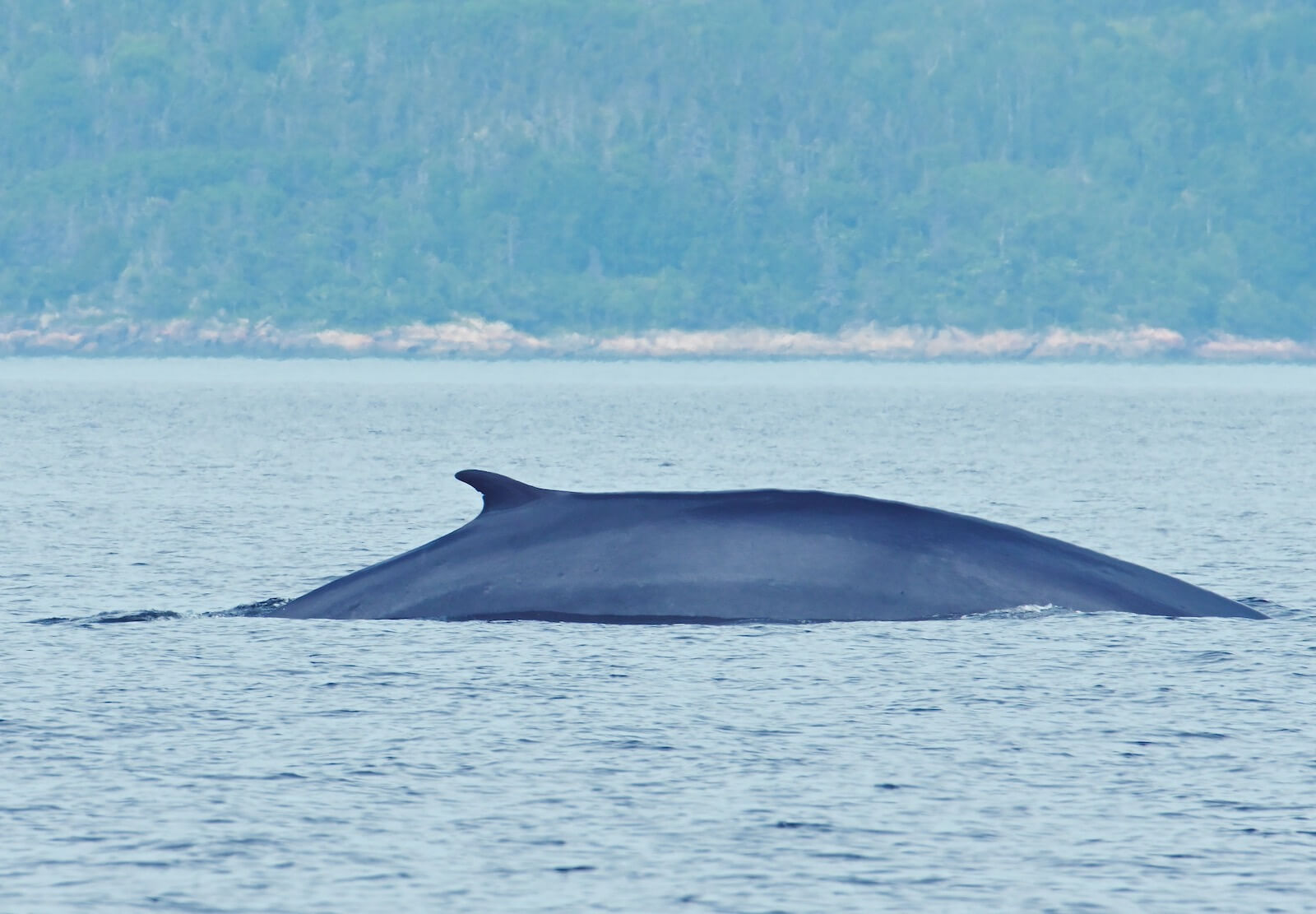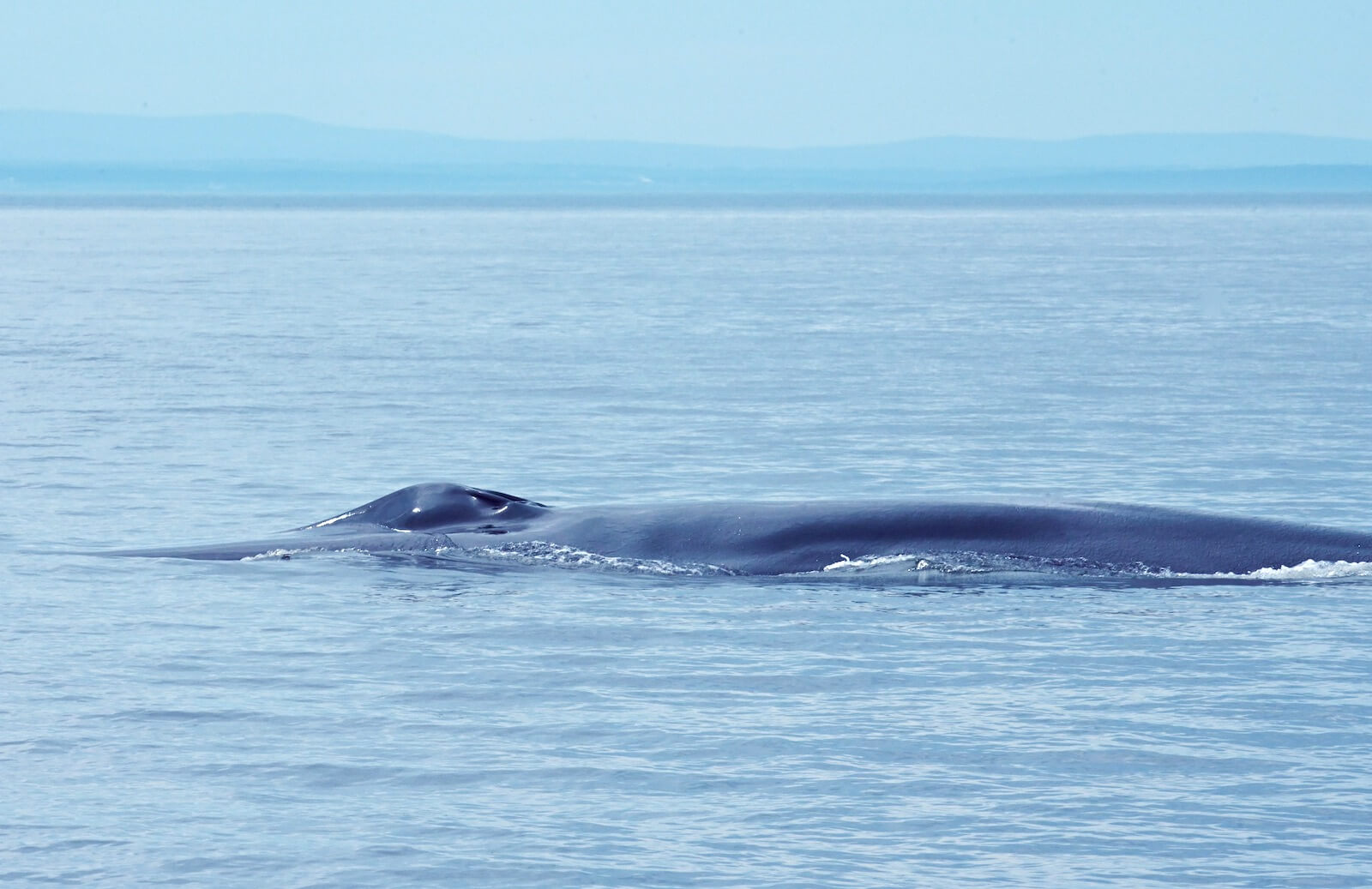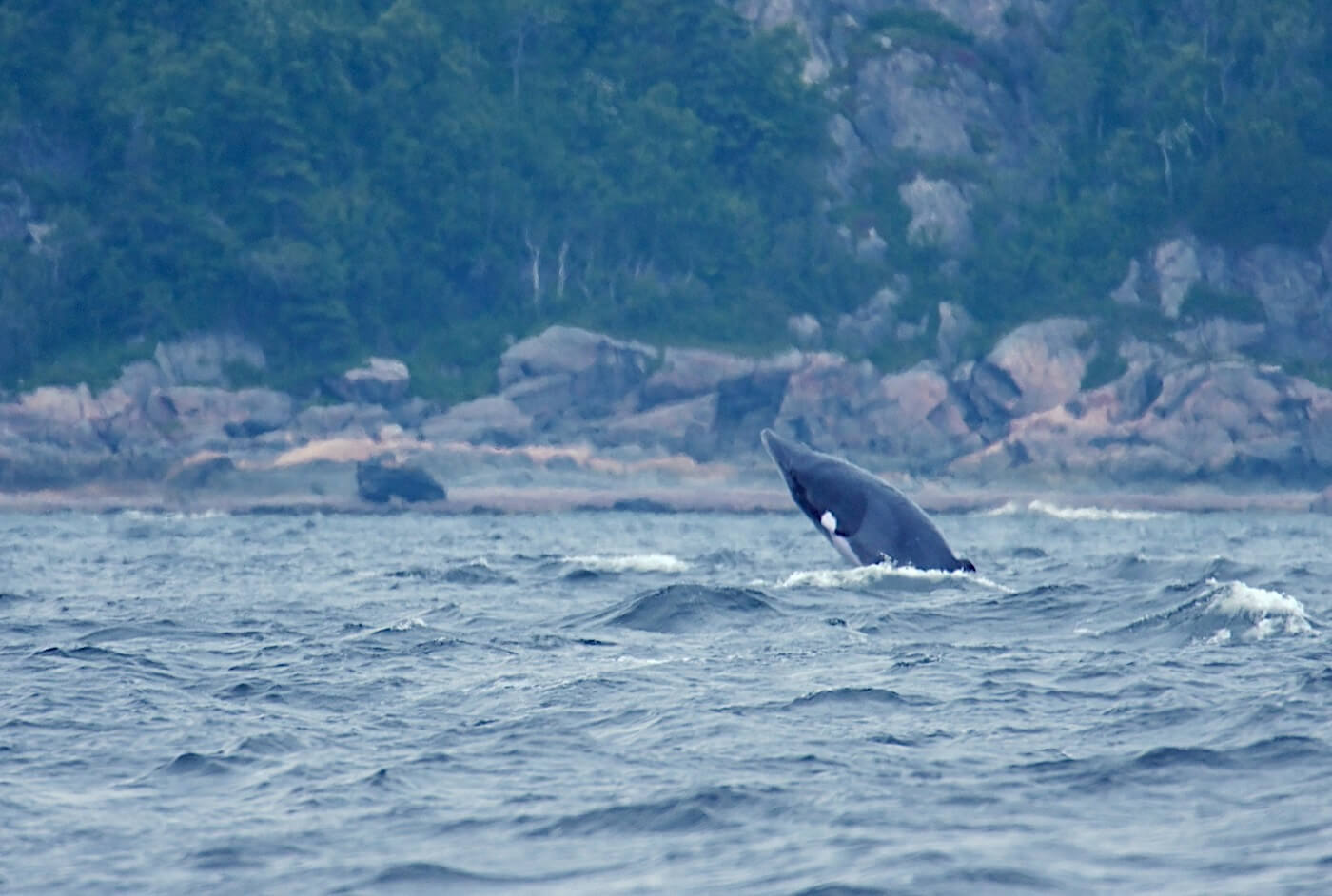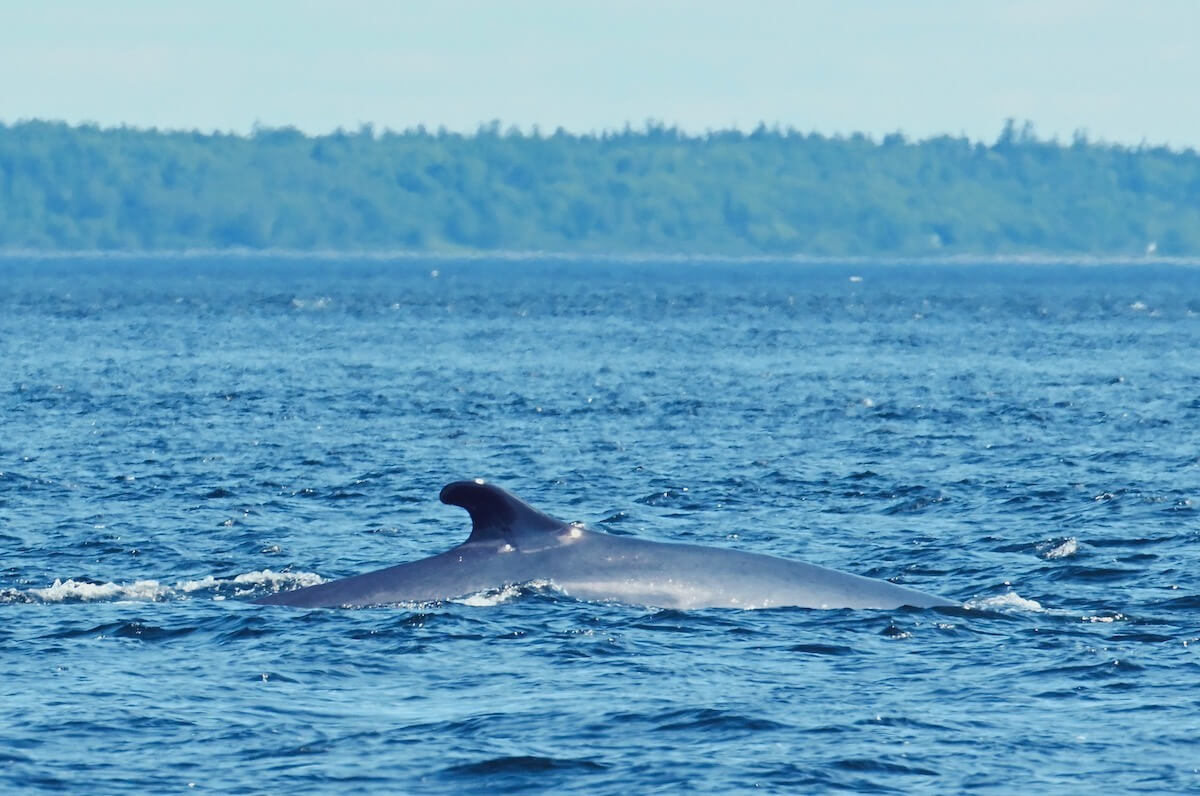With the heatwave of the last few days, the cool, refreshing winds blowing over the river were certainly more than welcome. There’s nothing like time spent on the coast to observe minke whales, harbour porpoises, belugas or large rorquals. As it turns out, observers are pondering the presence of a whale whose identity remains a mystery: could it be a blue whale, a fin whale, or even a hybrid?
Part blue, part fin
It was in Les Bergeronnes that a marine mammal enthusiast made an unusual sighting: “On Sunday afternoon at Cap de Bon-Désir, there was a potentially hybrid large rorqual that came very close to shore. It looks a lot like a fin whale, but something about its colouring was a bit odd.” For one naturalist and wildlife photographer who also saw the large rorqual, there were a number of things that were confusing, including the fin whale-like dorsal. On the other hand, the animal’s size, blowhole, spout and behaviour were more like those of a blue whale. As for the colouring, it seemed mixed. We will have to wait for the opinion of scientists and, who knows, perhaps other observations or even a biopsy before we can confirm the ID.
Hybridization is a widespread phenomenon in animals. One example that comes to mind is cross-breeding between horses and donkeys, which produces a mule or a hinny. The offspring of this cross are generally infertile. Could this be the case for whales? The existence of hybrids resulting from cross-breeding between a fin whale and a blue whale has been known since the 1990s. One study demonstrated that these hybrids can not only reproduce, but also survive until adulthood. Of the eight individuals studied in this research, seven were the result of a cross between a male fin whale and a female blue whale (or hybrid). Two hypotheses have been put forward to explain this trend: either it might be physically difficult for a male blue whale to mate with a female fin whale, or female blue whales might be struggling to find mates of their own species with which to reproduce.
A broad array of whales and seals
Out in the Gaspé, the mercury has been fluctuating between 23 and 30°C. Ideal conditions for heading to the salt water to cool off and gazing out to sea while scanning for dorsal fins! Sipping his coffee on his porch one morning, one resident was amazed to spot a whale: “The humpback appeared less than 100 metres from the shoreline. So close, it would’ve been impossible for me not to see it blow!” One naturalist details the full range of marine fauna that has been frequenting the area: “A few harbour seals and porpoises in Gaspé Bay. Grey seals are still rare. Otherwise, up to ten humpbacks and a few fin whales are in the area, not to mention minke whales.”
On the opposite side of the gulf, minke whales and seals were spotted near Havre-Saint-Pierre. “The minkes were feeding: they emerged a good twenty times if not more,” explains the observer. I had a good 15 minutes of active observation. I think there were also porpoises, but I didn’t have my binoculars.” Species diversity is essentially the same in the Franquelin area, save for the additional presence of harbour porpoises. A little farther west, harbour seals and belugas have been frequenting the south shore between Saint-Roch-des-Aulnaies and Notre-Dame-des-Neiges. In Saint-Siméon, it was minke whales that were spotted!
Belugas in Baie Sainte-Marguerite
From Baie Sainte-Marguerite, the “Window on Belugas” team observed a mixed herd of more than fifteen belugas. A research assistant tells us about this first day that kicks off the new season with a bang: “Some groups of females and young were in the bay while others, including groups of males, were opposite the rest area. Behaviour-wise, we made a most interesting observation amongst the groups of males, with splashing and heads sticking out of the water! There was also a harbour seal that came to pay us a visit. Toward the end, the belugas had come closer to the rest area and we could see them through the clear water!”
As part of the “Window on Belugas” project, images and sounds captured by the beluga brigades are transmitted to a network of land-based observation sites. The naturalists will invite visitors to view belugas like they never have before. Several sites will offer the experience in 2024: Fjord-du-Saguenay National Park, the Baie-Sainte-Marguerite sector in Sacré-Coeur, the Putep ’t-awt beluga observation site in Cacouna, and the Marine Mammal Interpretation Centre in Tadoussac.
Whales in the Marine Park!
On June 13, from the ferry docks in Les Escoumins, one cetacean enthusiast spots a large rorqual: “The fog slowly lifted to reveal a fin whale swimming eastward for a single sequence of respirations quite close to the docks. Its powerful breaths could be heard despite the stormy weather. Also, from Pointe de l’Islet, a small group of belugas with individuals ranging from brown to bluish to pure white.” On a day of turbulent winds, a minke whale breached several times, torpedoing its entire body through the water and landing between the waves.
Near the Marine Mammal Interpretation Centre in Tadoussac, a minke whale has been swimming in the mouth of the fjord almost every day, much to the delight of those who are able to admire it from shore. Sometimes belugas join them, moving in one direction or another at the gates of the Saguenay. On June 18, it was a harbour seal that showed the tip of its nose. Was it the same one that appeared a little later that evening in Tadoussac Bay? Who knows!
Two stars are currently roaming the Marine Park: the fin whale Ti Croche and the humpback whale Irisept. At least for these individuals, we know what species they are!
Where are the whales this week? Observation map
These data were reported by our network of observers. They give an idea of the presence of whales and in no way represent the actual distribution of whales in the St. Lawrence. Just for fun!
Click on the whale or seal icons to discover the species, the number of individuals, additional information or photos of the sighting. To enlarge the map, click on the icon in the top right-hand corner. The map works well on Chrome and Firefox, but not so well on Safari.
To display the list of sightings, click on the icon in the top left-hand corner.
Thanks to all our collaborators!
Special thanks go out to all our observers who share their love for marine mammals with us! Your encounters with cetaceans and pinnipeds are always a pleasure to read and discover.
On the water or from shore, it is your eyes that give life to this column.
Rachel Bois
Romy Bouchard
Odélie Brouillette
Guylaine Côté
Marie-Andrée Charleboix
Thalia Cohen-Bacry
Laetitia Desbordes
Léa Gosselin
Geoffroy Ingret
Ninon Lambs
Jade-Audrey Lavergne
Kevin Maltese-Crottier
Yael Medav
Élizabeth Melis
Camille Nem
Diane Ostiguy
Estelle Pagé
Chloé Pazart
Renaud Pintiaux
Pascal Pitre
Christine Stadelmann
Jean Roy
René Roy
Marie-Hélène Simard
Caro Simoneau
Andréanne Sylvain
Marielle Vanasse
Et à tous les autres!
Additionally, we would like to acknowledge the following teams that also share their sightings:
Sept-Îles Research and Education Centre (CERSI)
Group for Research and Education on Marine Mammals (GREMM)
Marine Mammal Observation Network (MMON)
Quebec Marine Mammal Emergency Response Network (QMMERN)
Mingan Island Cetacean Study (MICS)
Would you also like to share your observations?
Have you seen any marine mammals in the St. Lawrence? Whether it’s a spout offshore or just a couple of seals, drop us a line and send your photos to [email protected]!










